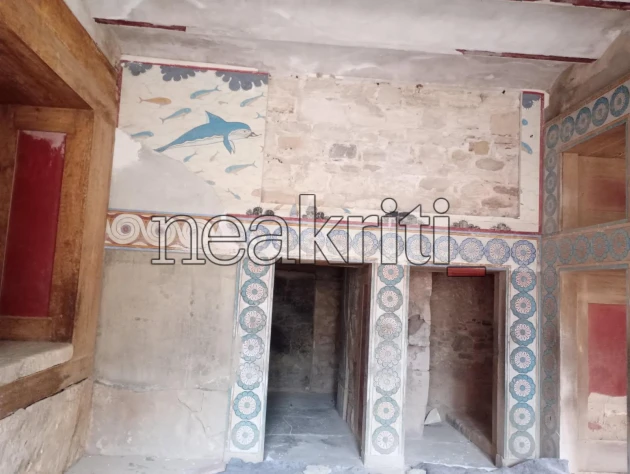A serious incident has drawn attention to the long-standing maintenance issues plaguing one of Greece’s most iconic archaeological sites. A section of the famous dolphin fresco at the Palace of Knossos – a symbol deeply tied to the image of Minoan civilization and prominently restored by Arthur Evans – suddenly collapsed on Friday morning. The event, which cannot be blamed on weather conditions, raises critical concerns about the monument's upkeep, especially as Knossos seeks inclusion on the UNESCO World Heritage list.
A Wake-Up Call at a Symbol of Minoan Art
The collapse took place in one of the most recognized parts of the Knossos complex. The damaged artwork, although a reproduction of the original restored by Evans over a century ago, remains an integral and iconic part of the site and a hallmark of Minoan artistic heritage.
At the time of the incident, approximately 300 visitors were inside the archaeological area. Reports indicate that the collapse occurred shortly after noon, just as authorities had begun evacuating the site due to strong winds sweeping through the region.
The fresco, made of plaster, consisted of three parts. Initial assessments reveal that two of them detached and fell, sustaining serious damage and breaking upon impact.
The collapse occurred in the eastern wing of the palace, which has now been cordoned off and will remain closed until further notice for safety inspections and damage assessment.
Ministry Responds – But Is It Too Late?
According to neakriti.gr, the Ministry of Culture has already been notified and has called for the immediate restoration of the fresco to prevent further deterioration and to safeguard the rest of the monument.
The incident has sparked widespread frustration, especially among tour guides, archaeologists, and local stakeholders who have been sounding the alarm for years. They’ve warned repeatedly about the site’s deteriorating condition and the pressing need for restoration—concerns that have gone largely unanswered.
Despite numerous announcements over the years promising conservation efforts, the current state of the palace remains disappointing. Experts describe certain parts of the site as neglected and vulnerable.
Those working daily at Knossos insist the monument no longer needs more studies or promises—it needs urgent intervention. Many claim Friday’s collapse was not a surprise, but an inevitability.
Not Weather – Neglect to Blame
Officials stress that the collapse cannot be blamed on the strong winds alone, as the damaged section was made of mortar, not particularly prone to weather-induced failure. Everything points to poor maintenance as the root cause.
This makes the event even more alarming, as it comes at a pivotal moment: the site's ongoing bid to be recognized by UNESCO as a World Heritage Site.
It's worth noting that the original dolphin fresco remains preserved at the Heraklion Archaeological Museum.
Storm Winds Force Evacuation and Temporary Closure
Earlier in the day, authorities had taken the precautionary step of evacuating the site due to gale-force winds. The Ministry of Culture had announced the temporary closure of the site between 1:00 and 4:00 p.m. to ensure the safety of both visitors and staff.
While the Palace of Knossos usually remains open until 8:00 p.m., the ministry reiterated that the protection of the monument and the safety of the public are non-negotiable priorities.
Public Shock and Sadness – A Call for Immediate Action
Images of the fallen fresco quickly spread across the internet, evoking sadness and dismay. For locals, staff, and those familiar with the rich history of Knossos, the damage represents more than just a structural loss—it’s a blow to cultural memory.
Before the collapse, the fresco was a vibrant testament to Minoan artistry.
Now, there's an urgent and undeniable need for a comprehensive restoration plan and decisive intervention. Authorities must act swiftly—before more of this invaluable cultural legacy is lost forever.








